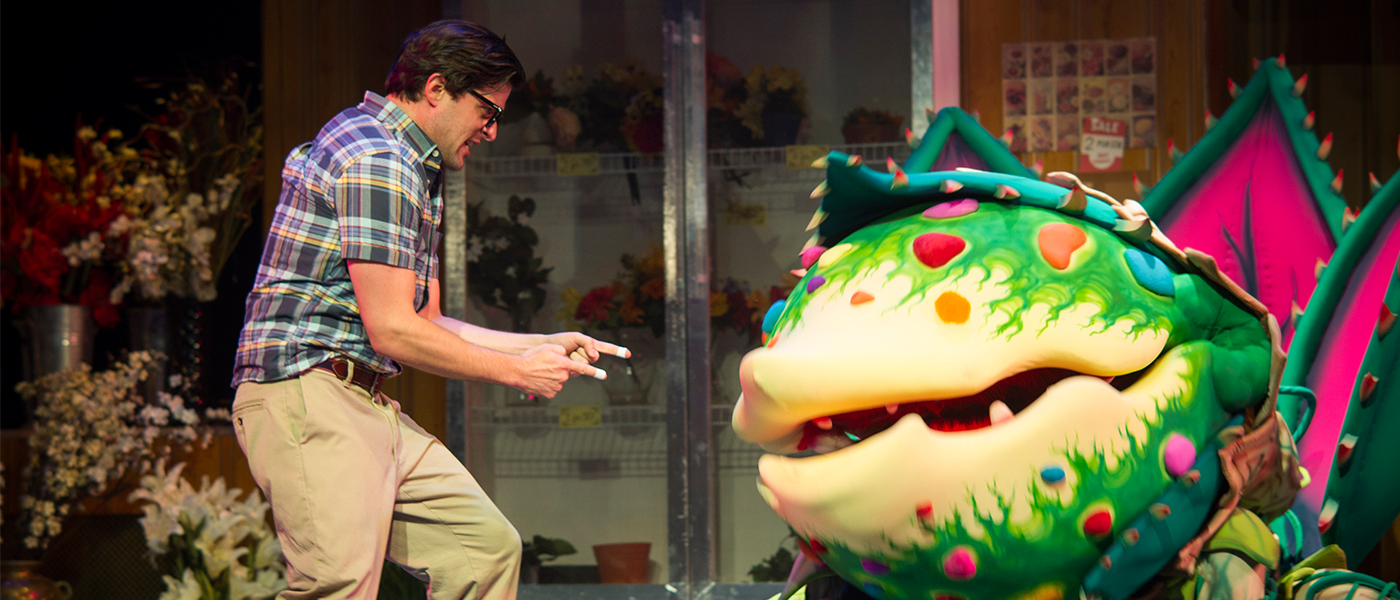To launch her first season as artistic director at Ithaca’s Hangar Theatre, Jen Waldman delivered a crackling good production of John Logan’s drama Red. With David Studwell as the towering painter Mark Rothko, one could not have asked for a more stimulating dance of ideas about aesthetics and self. Just a few weeks later Waldman and Studwell are back again in Howard Ashman and Alan Menkin’s Little Shop of Horrors (running through July 26). But, whoa! This does not mean the company has slid down a cultural pole. In Waldman’s hands, Little Shop is also a cultural adventure, as well as being a helluva lot of fun.
The idea of the uncontrollable growth of the carnivorous plant Audrey II originated in the fevered mind of B-movie genius Roger Corman back in 1960. While that movie and this musical never preach, nearly everyone is in on the gag. It’s the kind of thing that gives American pop culture its international prestige, from Buster Keaton through Batman comics. What looks to be mindless, broad-market entertainment is rife with intellectual energy we do not stoop to discuss. Maybe some people miss it. If Rep. Paul Ryan and other votaries of Ayn Rand realized the meaning of Andrey II’s bellowing “Feed me,” they’d stomp out of the theater.
Key to Waldman’s interpretation is David L. Arsenault’s set, which makes the Skid Row Florists shop look like a painting Edward Hopper meant to get to but neglected. With Adam J. Frank’s lighting design, we see most of the action through the front window, while the rest of the stage is enveloped in darkness. Intruders of all kinds come in from the dark. But usually it is the habitat of the three streetwise urchins, Crystal (Jennifer Theriot), Ronnette (Anissa Felix) and Chiffon (Brinie Wallace), a doo-wop Greek chorus. Howard Ashman’s book specifies that these be African-American performers, singing in the style of 1950s girl groups who preceded The Supremes. Their presence also acknowledges that the musical idiom of the score was expropriated from black America.
Bespectacled Steve Pacek is less nerdy than other Seymours, but that’s OK. He looks like a shorter Clark Kent, making us more likely to excuse his stumbling and also anticipate his resourcefulness. Pacek’s excellent vocal chops show off his solos, like “Grow for Me,” and blend well in the important duets with Audrey (Isabel Santiago), like “Suddenly Seymour,” the show’s best-remembered number.
Santiago, previously seen as a soprano soloist in Mozart’s Requiem as well as Maria in West Side Story, brings much comic inventiveness to Audrey, as well as enormous vocal expressiveness. She’s supposed to have tacky taste in clothes and even worse in men, favoring brutes who blacken her eyes, yet is still irresistible to Seymour. Her first-act solo, “Somewhere That’s Green,” expressing a deeply felt longing to live in a tract house, is written to mock slum girl aspirations, but Santiago delivers it with such conviction and sincerity the audience does not dare to sneer.
Which leads us back to David Studwell as Mr. Mushnik, the imperceptive owner of Skid Row Florists. As written, Mushnik is a hotheaded bully who does not comprehend what Seymour has given to him until he succumbs to the greed Audrey II engenders. Waldman and Studwell give Mushnik a humanizing Yiddish lilt, a dimension that leads to klezmer motifs for Mushnik’s big duet with Seymour, “Mushnik and Son,” in which the boss “adopts” to keep the boy tethered to Skid Row.
There are at least eight other human characters (some are on for only seconds) in the action, all played by the protean Bruce Warren. A graduate of Ithaca College, Warren appeared at the Hangar 12 years ago, but he’s been a star character player at Auburn’s Merry-Go-Round Playhouse for many summers. Not incidentally, director Waldman served some of her apprenticeship for the Hangar at the same venue, and knew she had the right man with a goatee and a distinctive silhouette who could still look entirely different at each appearance, once in drag as Mrs. Luce.
Comedy, as the man said, is harder than death. In his major incarnation Warren becomes Dr. Orin Scrivello, a motorcycle-riding sadistic dentist who has to immolate himself before us in a transparent helmet filled with laughing gas.
The several incarnations of Audrey II look to be the biggest seen in these parts. The man-eating monster plant speaks with a female voice, that of leather-lunged Erin Maya.
PHOTO: Steve Pacek and Audrey II in Hangar Theatre’s Little Shop of Horrors.
[fbcomments url="" width="100%" count="on"]









